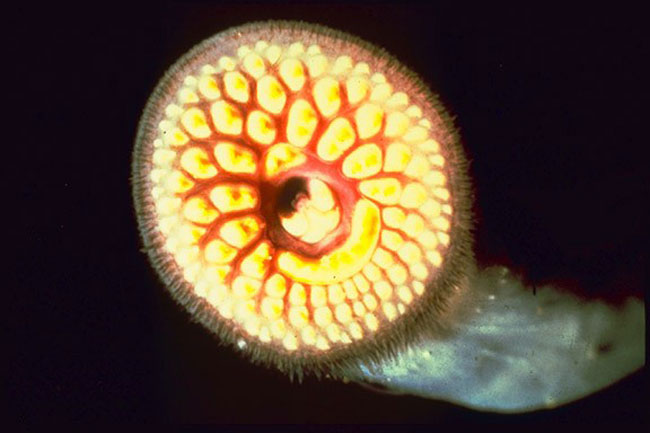Odd Fish Jawless for 360 Million Years

They lack jaws, eyes and bones, but lampreys and their "primitive" anatomy have survived 360 million years and four major extinctions relatively unaltered, suggests a new study.
Scientists unearthed and analyzed the oldest lamprey fossil [image] ever discovered, finding that it had a mouth nearly identical to today’s lamprey.
"This fossil changes how we look at lampreys today," said study team member Michael Coates of the University of Chicago. "They're very ancient, very primitive animals, yet with highly specialized feeding habits."
Feeding habits
Fish living 5 million years ago lacked many modern features, including jaws. While most primitive swimmers either went extinct or evolved into their modern jaw-equipped descendants, lampreys and hagfish split off and never morphed. Of the 46,000 known species of vertebrates, lampreys and hagfish are the only surviving jawless vertebrates.
Modern lampreys attach their circular mouth suckers to unsuspecting fish. After puncturing their host’s skin, they slurp up fishy body fluids before detaching and slithering away. Hagfish move their mouth parts similar to how a book opens and closes to chow down on other fish [video].
Until now, scientists had dug up just one hagfish and three lamprey fossils, all of which were preserved sideways so that any evidence of their specialized feeding parts was hidden.
Sign up for the Live Science daily newsletter now
Get the world’s most fascinating discoveries delivered straight to your inbox.
The bodies of lampreys and hagfish are also more vulnerable to decay. “They don’t have a bone in their bodies. They’re just cartilage and soft tissue, so the fossil record is appalling,” Coates told LiveScience.
Fishy find
The scientists, led by Robert Gess of the University of Witwatersrand in South Africa unearthed the fossil in an ancient estuary in Grahamstown, South Africa. Preserved showing its underside, the nearly complete soft-tissue fossil (Priscomyzon riniensis) is about two inches long with a circular mouth, proportionately larger than modern lampreys, surrounded by 14 teeth [image].
“They specialized early and they specialized successfully," Coates explained. "Early on they specialized and adopted an anatomical and behavioral strategy option which has served them through a subsequent 360 million years and it’s allowed them to slip through a whole series of big extinction events."
The study is detailed in the Oct. 26 issue of the journal Nature.
- All About Fish
- Images: Freaky Fish
- Images: The Ugliest Animals
- Top 10 Animal Senses Humans Don’t Have
Jeanna Bryner is managing editor of Scientific American. Previously she was editor in chief of Live Science and, prior to that, an editor at Scholastic's Science World magazine. Bryner has an English degree from Salisbury University, a master's degree in biogeochemistry and environmental sciences from the University of Maryland and a graduate science journalism degree from New York University. She has worked as a biologist in Florida, where she monitored wetlands and did field surveys for endangered species, including the gorgeous Florida Scrub Jay. She also received an ocean sciences journalism fellowship from the Woods Hole Oceanographic Institution. She is a firm believer that science is for everyone and that just about everything can be viewed through the lens of science.










